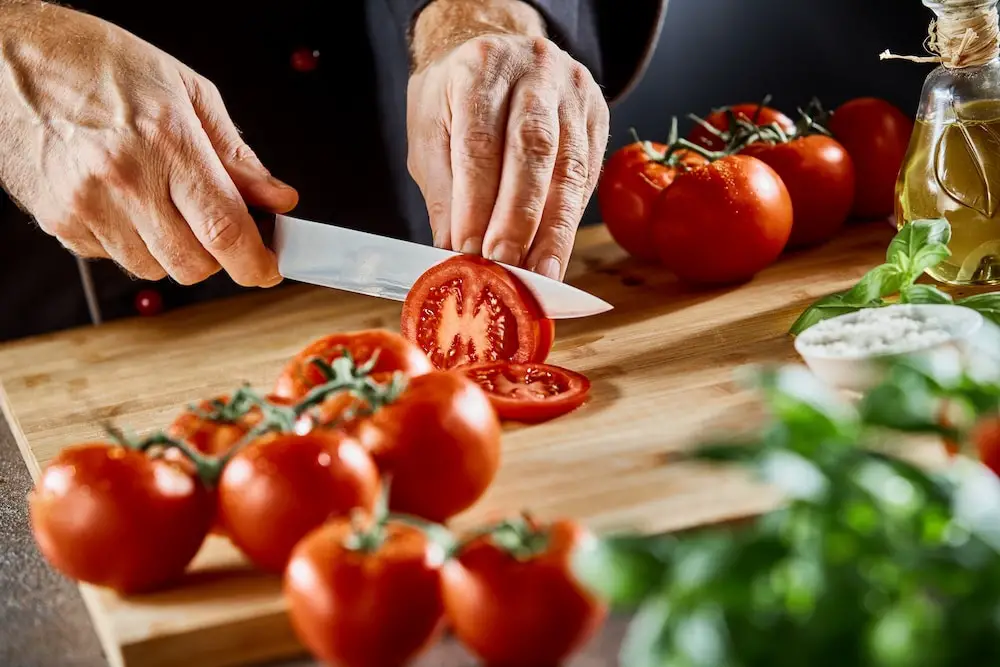More often than not, the kitchen is the most frequented and the busiest place in a house.
Anyone who has tried improving their cooking skills knows that preparing a meal is not easy; often, it requires the use of a variety of kitchen tools.
Among the essentials is the knife. In case you’re not aware, there are many different kinds of knives used for meal prep, one of which is the slicing knife.
To ensure your safety and that you’re utilizing it correctly, we prepared this guide on how to use a slicing knife.
What Is a Slicing Knife?
Before we give you the tips to using a slicer, let’s first talk about the basics.
What is a slicer knife, anyway?
The most distinguishable characteristic of a slicing knife is its long, thin blade (about eight to 14 inches in length) and its round tip.
It is a bit similar to carving knives in terms of length but is more flexible so you can use it to cut thinner slices.
It’s designed to slice thin cuts of cooked or smoked meat, poultry, and even fish.
Generally speaking, it is made to be thin and lightweight so that slicing jobs are completed faster.
Compared to other kitchen knives, it is the handiest and most efficient to use.
What Is a Slicing Knife Used for?
Now that you know what is a slicer knife, you might be wondering what is a slicing knife used for.
To get to know your kitchen tool better, let’s go back to its blade type and characteristics.
With its long thin blade, slicing knife uses include cutting thinner slices of roast meat, chicken, fish and the like.
It is also used for preparing fruits and vegetables for salads or for serving them as they are.
If you want your meals to look professionally sliced, this is your knife.
Since the slicer knife is thin and flexible, it is not ideal for splitting meat bones and for small-scale precision tasks, such as mincing and peeling.
Do note that the Japanese not only cut food into their selected size but cut it to make it delicious, too.
Slicing can alter the taste of food. Since food has cells and fibers, how you slice the ingredients can change its taste.
Do I Need a Slicing Knife?
In trying to find out what is a slicing knife, it’s clear to see that it’s a convenient kitchen tool to have at hand.
Even though it is not included in the three essential knives to have in the kitchen, a slicer can make your dishes presentable as if sliced by an expert.
Whether you are a restaurant owner, an aspiring chef, or the designated cook of the family, you’ll find that it is a good investment.
It’ll help make food prep easier and faster, and it won’t cause strain on your slicing hand and wrist.
As mentioned, a slicing knife uses a long, thin blade, making it suitable for cutting meat portions exactly the way you want them sliced.

How Do You Hold a Knife When Slicing?
A knife’s necessity and uses are not the only essential information about knives; determining how to utilize it for its purpose is just as crucial.
So, how do you hold a knife when slicing?
For this, you need to be familiar with the cutting hand, guiding hand, and claw grip.
The Cutting and Guiding Hand
The cutting hand is in charge of the knife movement and exerts optimum pressure for each cut or slice. This is usually the user’s predominant hand.
The guiding hand makes sure the food stays steady as you slice.
It plays an important supporting role and, at the same time, mostly involved in accidental injuries.
To avoid this, hand positioning when holding a knife is critical.
The Claw Grip
A claw grip is one of the many variations of positioning for the guiding hand.
This type of grip is most applied when slicing, as it prevents injury and helps you hold the food properly.
To perform the claw grip, make a claw shape using your guiding hand by curling your fingers inwards.
The thumb of your guiding hand should be positioned low down on the food to aid stability.
Keep this shape, and then rest your fingertips on the food.
If done correctly, you are building a “shield” that will protect your fingers from the knife’s sharp blade.
How To Use a Slicing Knife
Now that you know how to hold a knife when slicing, we can go ahead and talk about how you can use it.
To begin cutting, follow the steps below.
With your index finger resting flat against the blade near the handle, hold the handle with your middle, ring, and pinky fingers.
Then, position your thumb on the opposite side of the blade.
Professional chefs also sometimes use the “pinch grip,” which is another effective and safe way to hold a knife.
To do this, pinch the blade between your forefinger and thumb with the rest of the fingers under the handle.
In this way, there is more centered balance and control over the knife.
What Are 3 Knife Safety Tips?
We all know that knives can be dangerous and cause injuries if not used correctly.
To enjoy creating dishes with specialty knives without sacrificing your safety, keep these safety tips in mind.
1. Cutting Away Is the Key
Always cut away from your body or another person, as there is a possibility of an accident or the blade slipping.
This will not only protect you from injury but also protect others from potential harm.
2. Always Use a Sharp Knife
Keep your knives sharp.
Cutting with a dull blade means you have to exert more effort when slicing, which increases your risk of accidents.
3. Pay Attention
Stay focused on what you are cutting; otherwise, your meal might include a cut finger on the side.
Injuries and accidents with knives often occur when a person is distracted.
Do not attempt to multitask. It may help you save time but not your fingers from being cut.
Final Thoughts
Knives are essential kitchen tools you use to create delicious and visually appealing dishes at home.
A slicing knife is definitely worth investing in to complete your blade collection.
Just make sure you learn how to use a slicing knife and follow proper maintenance tips so as to avoid accidents.

